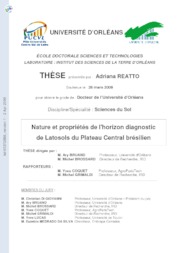Nature et propriétés de l'horizon diagnostic de Latosols du Plateau Central brésilien.
Nature et propriétés de l'horizon diagnostic de Latosols du Plateau Central brésilien.
Author(s): REATTO, A.
Summary: The Latosols correspond to about 40% of the Brazilian Central Plateau. They are characterized by low activity clay, little horizon differentiation, a weak macrostructure and a strong microgranular structure resulting in microaggregates 50 to 300um in size. Ten Latosols (L) were selected along a 350-km long regional toposequence across the South American Surface (SAS) (L1 to L4) and Velhas Surface (VS) (L5 to L10). The studied Latosols take into account the textural and mineralogical variability, as well as the topographical location and parental material variability. Our results showed a large variation of the kaolinite and gibbsite content in relation to a regional component attributed to the age of the geomorphic surface and a local component mainly related to the hydraulic conditions along the toposequence. The results showed also that the microgranular structure varied without any relationship with the texture and mineralogy of the fine material. It appeared as being mainly related to soil bioturbation by termites. The microaggregates of the Latosols studied are not rigid but shrink during drying with no relation with the mineralogy of the fine material. Our results showed that the microaggregates od the Latosols located on the SAS shrink less than those of the Latosols located on the VS. This would be related to a difference of hydric stress history. Finally, the water retention properties and saturated hydraulic conductivity varied according to the clay content and development of pores larger than 300um in diameter respectively without any apparent role of the mineralogy of the fine material.
Publication year: 2009
Types of publication: Theses
Unit: Embrapa Cerrados
Observation
Some of Embrapa's publications are published as ePub files. To read them, use or download one of the following free software options to your computer or mobile device. Android: Google Play Books; IOS: iBooks; Windows and Linux: Calibre.
Access other publications
Access the Agricultural Research Database (BDPA) to consult Embrapa's full library collection and records.
Visit Embrapa Bookstore to purchase books and other publications sold by Embrapa.

